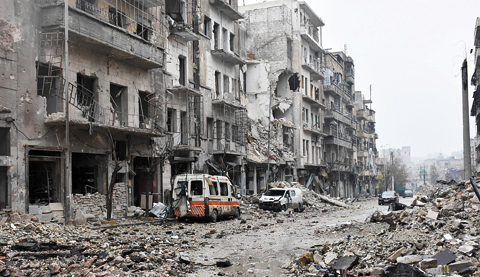 ALEPPO: A general view shows a severely damaged street in Aleppo’s Al-Kalasseh neighborhood in the eastern part of the war torn city. —AFP
ALEPPO: A general view shows a severely damaged street in Aleppo’s Al-Kalasseh neighborhood in the eastern part of the war torn city. —AFPALEPPO: Once renowned for its bustling souks, grand citadel and historic gates, Aleppo's Old City has been rendered virtually unrecognizable by some of the worst violence of Syria's war. For centuries, Aleppo was Syria's economic and cultural powerhouse, attracting tourists from around the world to its celebrated heritage sites. But now, only gaunt stray cats roam the rubble-strewn alleyways of its Old City, a UNESCO World Heritage site, after years of savage conflict. In the famed Al-Hatab Square, recently recaptured by the Syrian army, lawyer and Aleppian historian Alaa Al-Sayyed could scarcely believe his eyes.
Al-Hatab was one of the oldest squares in the city, but it now lay dotted with sand barricades and the charred remnants of overturned buses. "I couldn't even recognize it because it was so severely damaged. I told myself, this can't be Al-Hatab square," he said. The Old City became one of Aleppo's bloodiest front lines after rebel groups overran the eastern half of the city in mid-2012, a year after the conflict began with anti-government protests.
For four years, it was caught between opposition factions in the east and government forces in the west. Fighting destroyed the 11th century minaret of Aleppo's famed Ummayad mosque and heavily damaged the old Crusader citadel. Faced with a blistering offensive by forces loyal to President Bashar al-Assad, opposition factions withdrew from the Old City on December 7 in a highly symbolic retreat.
'Irreplaceable heritage'
Aleppo's covered market-the largest in the world-served for centuries as a gathering place for artisans and traders. They came from across the globe to its 4,000 shops and 40 caravanserais, roadside inns for travelers. But now the market's walls are scarred by years of gunfire, rockets and mortar rounds-attacks that Sayyed called "unjustifiable" because of the area's historical value. The market was "the economic heart of Aleppo and an irreplaceable piece of heritage", he said. Attacking it "was a decisive blow against Aleppo's economy, because thousands of Aleppian families, whether rich for poor, relied on the souk for their livelihoods."
Abu Ahmad, 50, once owned several shops in the old market where he sold vibrant fabrics that he produced elsewhere in the city. Forced to leave his storefronts behind as fighting there intensified, he opened a kiosk selling coffee and other hot drinks in the government-held Aleppo district of Furqan. "I sold my wife's jewelry so I could buy this kiosk," Abu Ahmad said, tears welling in his eyes and his voice cracking on a cold December morning. He said he hoped to return and find his old storefront intact, but was prepared to sell his car to rebuild if necessary. "I'm a tradesmen, and I don't want to leave my trade. I want to pass it on to my son," he said.
Ghost town
The war also ravaged the touristic area around Aleppo's famed citadel, including the Al-Sultaniyah mosque and the imposing white-stoned Grand Serail. The luxurious Carlton Hotel was completely leveled by a massive rebel tunnel bomb in February 2014. In nearby Aqyul district, the rows of demolished residential buildings seemed to extend endlessly towards neighboring Bab Al-Hadid. Broken washing machines, air conditioning units, and other household items lay in heaps outside, while torn pieces of blue canvas fluttered in window frames where the glass had been blown out by explosions.
One stray cat wandered aimlessly across the main street, pausing to sniff at a decaying body still lying in the street. Even the local cemetery did not survive the battle unscathed, with parts of shattered tombstones strewn across patches of dried grass. In Bab Al-Hadid, home to one of the city's best-preserved historical gates before the war, there was a similar silence. Near its square, which dates back to 1509 AD, storefronts were still painted with the three-star flag of Syria's beleaguered opposition. "From Houran (in the south) to Aleppo, the revolution continues," reads graffiti scrawled on a wall in the deserted neighborhood._ AFP









